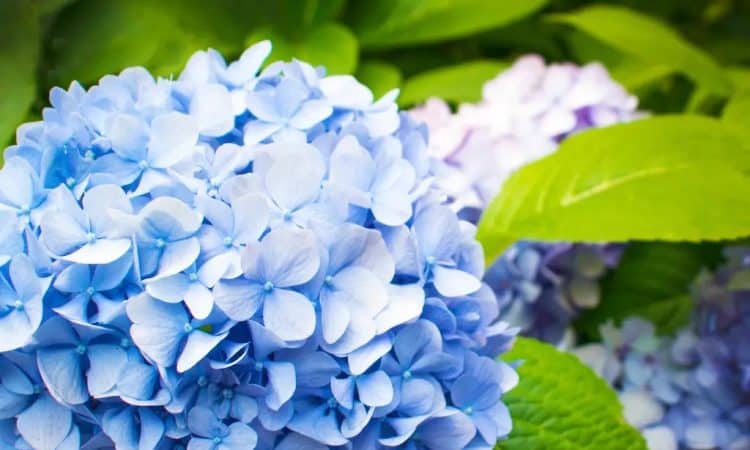
From the moment you plant your first hydrangea in your garden, you’re in for a ride. We can almost guarantee that sooner or later you will bring home more and more… for His Majesty the Hydrangea is a queen who is a pleasure to serve.
Hydrangeas are flowers that, when they thrive, flourish and bloom, win everyone over. There are several varieties, so you can choose which one is best for your garden or patio, or rather which one you can give the right conditions to. We’ll introduce them to you and tell you what they need to delight you with their beautiful flowers.
Hydrangea large-leaved
Probably the best known hydrangea species is the large-leaved hydrangea, Hydragea macrophylla. You may know it from the parks, but it was also found in your grandmother’s garden, where it was often near fences and often acted as a dominant feature of the whole property. To thrive, it needs a semi-shaded habitat where there is plenty of light but where the sun does not shine directly on it. The soil should be moist, loose and acidic – it won’t thrive in classic alkaline soil, so it probably won’t flower.
To flower nicely, it needs not only the above conditions but also the right pruning, which you can read about below. If you find this difficult, choose plants that have Forever and Ever or Endless Summer in their name, which means they will flower on new and old shoots.
Hydrangea latna
In gardens where there isn’t enough shade for large-leaved hydrangea to thrive, you can plant Hydrangea panniculata, the latent hydrangea. It can tolerate a sunny location. It also likes a more acidic soil, if you would like to mix it yourself, then it is compost, peat and sand in a ratio of 5:2:1.
The flowers are not classically shaped, they are more of a grape shape, but they can also come in many shades and sizes. In addition, they ideally complement the classic large-leaved variant, as they flower a little later.
Other types of hydrangeas
You can grow the tree hydrangea, Hydrangea arborescens, in a pot in the garden or on the patio. The climbing hydrangea, Hydrangea petiolaris, is also very showy. Another interesting hydrangea is the double-leaved hydrangea, Hydrangea quercifolia, which can grow up to two metres tall, its leaves resemble those of an oak tree and turn a burgundy red colour in autumn. A very popular cultivar is Hydrangea serrata, which is very hardy due to its origin in the mountainous regions of Korea and Japan. It has specific flowers that change colour.
Hydrangea flower colour
When you say hydrangea, most people think of the typical blue colour of the flowers. However, even if you buy one, it can change. Hydrangeas respond to the acidity of the soil with the colour of their flowers, so you can experiment a little. For the pink and red flowers of large-leaved and sawtooth hydrangeas , make a mixture of compost, clay, peat and sand in a ratio of 4:3:2:1; for white and blue flowers, the ratio should be 3:2:1.5:0.5 peat, compost, clay and sand.
Fertilizing hydrangeas
Even fertilising large-leaved hydrangeas can affect their colour, so if you want blue, buy a fertiliser specifically to promote this colour, but there is also one for pink flowers. Generally fertilise at flowering time, until about the end of August. For large-leaved ones, buy a special fertiliser, while the latent ones can get by with an all-purpose fertiliser.
Watering
Hydrangeas are among the plants that need regular watering. You should not let them dry out so much that their leaves start to wilt and dry out – and then overwater them. A consistently moist soil is ideal for them, but not waterlogged or standing in water. They are therefore ideal candidates for constant drip irrigation. They will definitely appreciate it if you mulch their surroundings to reduce water evaporation.
Cutting hydrangeas
Each hydrangea species needs a different pruning:
- Large-leaved ones bloom on biennial shoots, so in spring remove only the branches that didn’t survive the frost and shoots with withered inflorescences. The same is true of saw-leaved or double-leaved hydrangeas, which are those that flower on old wood. These species can be rejuvenated as needed, i.e. cut back to the same length in spring. Just remove any shoots that are too dense so they don’t shade themselves, but otherwise they don’t need anything more. You can make the rejuvenation cut during May or June.
- Latent or trefoil hydrangeas form buds in spring, so you can prune more, even beyond the first few buds – you can afford to do this because they flower on young shoots.
- You don’t need to prune climbing hydrangeas, just cut back what has died back after winter in spring.
Winter protection
The younger the hydrangea in your garden, the more protection you should give it for the winter. It’s easy to do – cover it with a lighter substrate, tufts or mulch, and you can also use healthy fallen leaves. If the hydrangea is already big and tall, you can tie it carefully together so that it doesn’t get buried under a layer of snow. But tie it carefully, not too tightly.
Diseases and pests of hydrangeas
The good news is that hydrangeas are mostly disease and pest free, so they are definitely not a delicate plant.
- They can develop grey mould, which you can tell by the grey coating on the leaves. The plant should then be treated with a suitable product.
- The purplish coating is caused by powdery mildew, which can also be treated with suitable products.
- Hydrangeas can also suffer from chlorosis, which is an iron deficiency – this then needs to be supplemented with a suitable watering, for example with water containing green lime. This problem is manifested by yellowing or bleaching of the leaves.
- If the hydrangea is attacked by mammalian and corrosive pests, use products that work on them.

